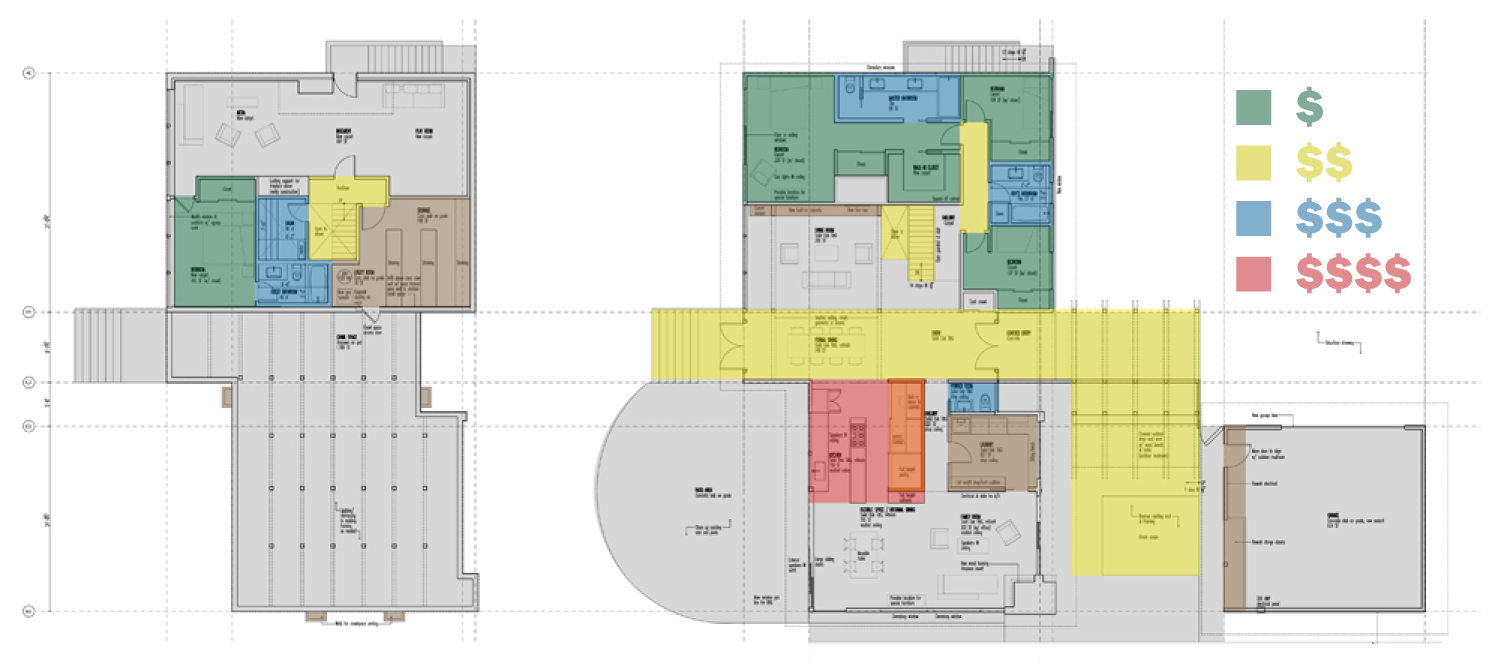
Being a highly cost-effective design-build firm, we spend a significant amount of time and effort on project budgets. We publish the construction costs of most of our projects, discuss pricing in many of our posts, and have even gone to the extent of designing a construction cost cheat sheet. To us, the design and the finances of a project are interconnected. We’ve never cared for the vague and uninformed approach toward construction costs that are all too common in the architecture industry. In fact, it’s common for us to dive into a realistic construction budget discussion as early on as the initial interview for a new project.
We have enough experience behind us now that we’re able to discuss a range of project types in terms of price per square foot. For instance, our residential remodels typically cost $150 to $175 per square foot. This is a quick method to align the design goals with the project budget and set appropriate expectations from the get-go. It allows sensible decisions to be made and it prevents the design from heading in the wrong financial direction. As straight-forward as this math is though, there is an important logic behind it; these square foot costs are averages. You can’t simply select a few defined areas of a home (say the kitchen and the master suite) and multiply the square footage of those areas by $150 to get the total cost of the remodel. One of many potential budget pitfalls is to optimistically apply $150/sf to specific areas, or manipulate the cost per square foot benchmark to meet inappropriate goals. This “cherry-picking” approach to the math doesn’t work for a number of reasons:
1. Asymmetrical Costs. Some areas of a home are much more expensive per square foot because they have a concentration of expensive features (appliances, plumbing fixtures, cabinetry, hardware, etc.) and are more labor intensive to build (involving carpenters, plumbers, electricians, drywallers, tile setters, painters, etc.). For instance, kitchens and bathrooms typically cost much more, and if pressed we’d say around $400 per square foot. This higher cost per square foot is balanced out by spaces like the living room (if pressed, more like $100/sf), bedrooms (if pressed, $75/sf) and the garage ($50/sf), resulting in a much lower cost per square foot over the entire house.
2. Good design is holistic. Rarely is it a good solution to simply update a couple of rooms in a worn-out house. Updating a home should include improvements to not only the doors & windows, surfaces, cabinets, fixtures, and appliance, but also to the lifestyle. The sequence of spaces, the relationship of rooms to each other, and the visual harmony of the design all play a significant role in a home remodel. If a kitchen and an entry way are each updated in an older home, the living room in between the two needs to be thought of as part of the package. The living room doesn’t necessarily require a complete overhaul, but it should at least be considered so that there isn’t a glaring dissonance of new adjacent to old. Successful remodels approach the home as a whole entity, not just a collection of rooms under a roof; the entire experience of the life within it is taken into account.
3. Systems don’t stop at the walls. Most remodels include updates to the plumbing, electrical and heating systems. Unfortunately, if there are galvanized pipes in the kitchen, they likely run all the way to the meter. Same with that knob and tube wiring and cobbled together ductwork that’s been hard at work for over 50 years. It’s possible to be selective in updating these systems but repairing such systems gets very expensive once the remodel is “finished.”
When you apply the principles of good design to a home remodel, the work usually includes more than just the room most in need of updates. The simple fact is that, no matter how cost-effective you are, doing a good job is expensive.
It’s not unusual to speak with potential clients about their remodel plans for their kitchen and master suite that they’d like to accomplish in the $75K range. We wish this were possible. We wish that construction was less expensive, but when you take into account the points above, the construction costs are typically a degree of magnitude greater. It’s always discouraging news and we hate being the rain cloud at the meeting. But we also like doing a good job and we like being honest (it helps us sleep at night). Bad news up front is free, bad news during construction is very expensive.
We think of ourselves as a design and construction team that has both feet on the ground; this involves realistic planning, clear communication, and setting appropriate expectations. Using these tools, we find that thorough and thoughtful remodels can be accomplished. Remodels which update the desired areas of a home, improve the overall lifestyle and make a home functional and inspiring for another 50-plus years. And the process is typically more expensive than people think. (But always cheaper than coming to the realization while hammers are already swinging.)
Keep both feet on the ground and cheers from Team BUILD





